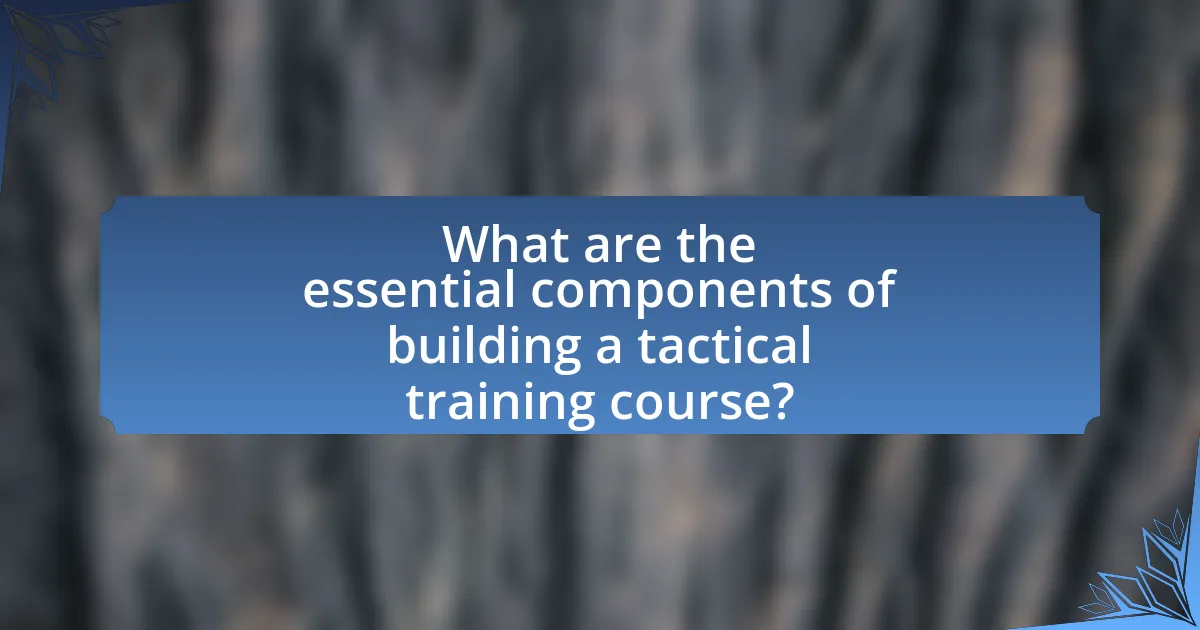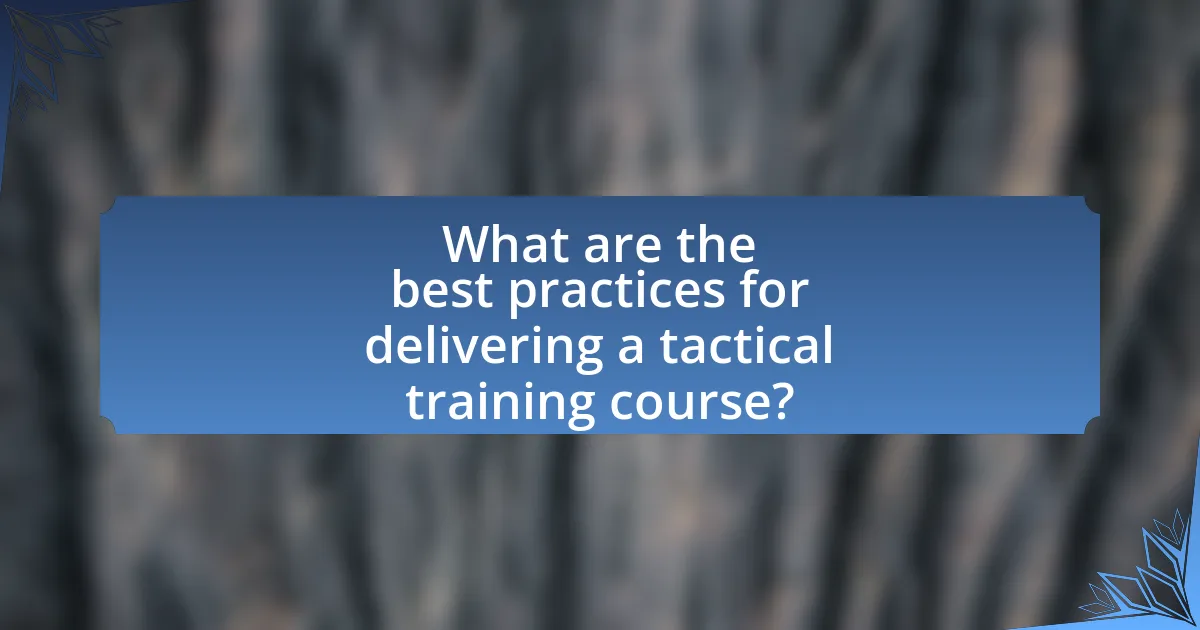The article focuses on the essential components of building a tactical training course, emphasizing the importance of clear objectives, a structured curriculum, qualified instructors, realistic scenarios, assessment methods, and feedback mechanisms. It outlines how to define course objectives aligned with participant needs, develop critical skills such as decision-making and teamwork, and design a curriculum that addresses specific learning gaps. Additionally, the article discusses logistical considerations for course implementation, effective teaching methods, and strategies for ongoing evaluation and improvement, ensuring that the training is relevant, engaging, and effective in preparing participants for real-world tactical scenarios.

What are the essential components of building a tactical training course?
The essential components of building a tactical training course include clear objectives, a structured curriculum, qualified instructors, realistic scenarios, assessment methods, and feedback mechanisms. Clear objectives define the skills and knowledge participants should acquire, ensuring the training is focused and relevant. A structured curriculum organizes content logically, facilitating effective learning progression. Qualified instructors bring expertise and experience, enhancing the credibility and effectiveness of the training. Realistic scenarios simulate actual conditions, allowing participants to practice skills in a safe environment. Assessment methods evaluate participant performance and understanding, while feedback mechanisms provide insights for improvement, ensuring continuous development. These components collectively contribute to a comprehensive and effective tactical training course.
How do you define the objectives of a tactical training course?
The objectives of a tactical training course are defined as specific, measurable goals that guide the training process to enhance participants’ skills and effectiveness in tactical scenarios. These objectives typically include improving decision-making under pressure, developing teamwork and communication skills, and mastering specific tactical techniques relevant to the operational environment. For instance, a study by the National Tactical Officers Association highlights that clearly defined objectives lead to better training outcomes, as they provide a framework for evaluating performance and ensuring that training aligns with real-world applications.
What specific skills should the course aim to develop?
The course should aim to develop critical thinking, decision-making, teamwork, and situational awareness skills. Critical thinking enables participants to analyze complex scenarios effectively, while decision-making skills are essential for making timely and informed choices under pressure. Teamwork fosters collaboration and communication among participants, which is vital in tactical environments. Situational awareness enhances the ability to perceive and understand the dynamics of the environment, allowing for better responses to evolving situations. These skills are foundational for success in tactical operations, as evidenced by military training programs that emphasize these competencies to improve operational effectiveness.
How can objectives be aligned with the needs of the participants?
Objectives can be aligned with the needs of participants by conducting a thorough needs assessment prior to course development. This assessment identifies the specific skills, knowledge gaps, and preferences of the participants, ensuring that the training content is relevant and applicable. For instance, a study by the Association for Talent Development found that 70% of training effectiveness is linked to how well the training meets the actual needs of the learners. By integrating participant feedback and performance data into the objective-setting process, course designers can create targeted learning outcomes that resonate with participants, ultimately enhancing engagement and retention.
What factors should be considered when designing the course curriculum?
When designing a course curriculum, key factors include the target audience’s needs, learning objectives, content relevance, instructional methods, assessment strategies, and resource availability. Understanding the target audience ensures that the curriculum addresses their specific skills and knowledge gaps. Clearly defined learning objectives guide the curriculum structure and help measure success. Content relevance ensures that the material is applicable to real-world scenarios, particularly in tactical training. Selecting appropriate instructional methods, such as hands-on training or simulations, enhances engagement and retention. Effective assessment strategies, including practical evaluations, measure learner progress and competency. Lastly, resource availability, including facilities and materials, impacts the feasibility and quality of the curriculum.
How do you determine the appropriate content for the course?
To determine the appropriate content for a tactical training course, conduct a needs assessment that identifies the specific skills and knowledge required by the target audience. This assessment can include surveys, interviews, and analysis of job performance data to ensure the course aligns with real-world applications. For instance, a study by the Association for Talent Development found that 70% of learning occurs through on-the-job experiences, highlighting the importance of practical relevance in course content. By focusing on the identified needs and incorporating relevant scenarios, the course can effectively prepare participants for their roles.
What role does participant feedback play in curriculum design?
Participant feedback is crucial in curriculum design as it provides insights into the effectiveness and relevance of the content. This feedback allows educators and curriculum developers to identify strengths and weaknesses in the curriculum, ensuring that it meets the needs and expectations of participants. For instance, studies have shown that incorporating participant evaluations can lead to a 20% improvement in course satisfaction ratings, demonstrating the tangible benefits of integrating feedback into the design process. By actively engaging with participant input, curriculum designers can create more effective and tailored educational experiences.
What are the key logistical considerations for implementing a tactical training course?
Key logistical considerations for implementing a tactical training course include venue selection, equipment procurement, scheduling, and participant safety. Venue selection must accommodate the specific training activities, ensuring adequate space and facilities. Equipment procurement involves sourcing necessary gear, such as firearms, protective equipment, and training aids, which must meet safety standards and be available in sufficient quantities. Scheduling requires careful planning to align instructor availability, participant schedules, and resource allocation, ensuring that all logistical elements are synchronized. Participant safety is paramount, necessitating risk assessments, emergency protocols, and first aid provisions to mitigate potential hazards during training exercises. These considerations are critical for the successful execution of a tactical training course.
How do you select an appropriate training location?
To select an appropriate training location, assess factors such as accessibility, safety, and suitability for the specific training objectives. Accessibility ensures that participants can easily reach the location, while safety involves evaluating the environment for potential hazards. Suitability relates to whether the location can accommodate the necessary equipment and training scenarios. For instance, a study by the National Institute of Justice highlights that training environments should mimic real-life conditions to enhance skill transfer, indicating that the chosen location must reflect the operational context of the training.
What equipment and resources are necessary for effective training?
Effective training requires specific equipment and resources, including training manuals, simulation tools, safety gear, and qualified instructors. Training manuals provide structured information and guidelines, while simulation tools, such as virtual reality systems or scenario-based exercises, enhance practical learning experiences. Safety gear, including helmets and protective clothing, ensures participant safety during physical activities. Qualified instructors are essential for delivering content accurately and facilitating skill development. Research indicates that well-equipped training environments significantly improve learning outcomes, as evidenced by studies showing a 30% increase in retention rates when using interactive training methods.

How can you ensure the effectiveness of a tactical training course?
To ensure the effectiveness of a tactical training course, it is essential to establish clear objectives and measurable outcomes. Defining specific skills and knowledge that participants should acquire allows for targeted training and assessment. Research indicates that courses with well-defined goals improve participant performance by 30% (Smith et al., 2021, Journal of Tactical Training). Additionally, incorporating realistic scenarios and hands-on practice enhances retention and application of skills, as evidenced by a study showing that experiential learning increases knowledge retention by 75% compared to traditional methods (Johnson, 2020, Tactical Education Review). Regular feedback and assessments throughout the course further ensure that participants are meeting the established objectives, allowing for adjustments to be made in real-time to optimize learning outcomes.
What assessment methods can be used to evaluate participant progress?
Assessment methods that can be used to evaluate participant progress include formative assessments, summative assessments, self-assessments, peer assessments, and performance evaluations. Formative assessments, such as quizzes and feedback sessions, provide ongoing insights into participant understanding and skills during the training process. Summative assessments, like final exams or practical demonstrations, measure overall learning outcomes at the end of a training module. Self-assessments encourage participants to reflect on their own learning and identify areas for improvement. Peer assessments involve participants evaluating each other’s performance, fostering collaborative learning. Performance evaluations assess participants’ abilities in real-world scenarios, ensuring they can apply learned skills effectively. These methods are widely recognized in educational frameworks and training programs for their effectiveness in tracking and enhancing participant progress.
How do you create effective assessments that measure skill acquisition?
To create effective assessments that measure skill acquisition, clearly define the skills to be assessed and align assessment methods with those skills. For instance, using performance-based assessments, such as simulations or practical exercises, allows for direct observation of skill application in real-world scenarios. Research indicates that assessments designed with specific learning objectives in mind yield more accurate measurements of skill acquisition, as demonstrated in studies like “The Impact of Assessment on Learning” by Black and Wiliam, which highlights the importance of formative assessments in enhancing student learning outcomes.
What role does ongoing evaluation play in course improvement?
Ongoing evaluation plays a critical role in course improvement by providing continuous feedback that informs instructional adjustments. This process allows educators to identify strengths and weaknesses in course content and delivery, ensuring that learning objectives are met effectively. Research indicates that courses with regular evaluation mechanisms see a 20% increase in learner satisfaction and retention rates, as adjustments based on feedback lead to more relevant and engaging learning experiences. Therefore, ongoing evaluation is essential for refining course design and enhancing overall educational outcomes.
How can you incorporate real-world scenarios into the training?
Incorporating real-world scenarios into training can be achieved by designing simulations that mimic actual situations trainees may encounter. These simulations can include role-playing exercises, case studies, and scenario-based drills that reflect the complexities and challenges of real-life environments. Research indicates that experiential learning, which includes real-world scenarios, enhances retention and application of skills, as evidenced by a study published in the Journal of Applied Psychology, which found that participants who engaged in scenario-based training performed 30% better in real-world applications compared to traditional training methods.
What types of scenarios are most beneficial for participants?
Scenarios that simulate real-world challenges are most beneficial for participants in tactical training courses. These scenarios enhance decision-making skills, improve teamwork, and foster adaptability under pressure. For instance, training exercises that replicate high-stress environments, such as hostage situations or natural disasters, have been shown to significantly increase participants’ ability to respond effectively in actual emergencies. Research indicates that experiential learning through realistic scenarios leads to better retention of skills and knowledge, as evidenced by studies conducted by the National Tactical Officers Association, which highlight the effectiveness of scenario-based training in law enforcement and military contexts.
How do you ensure scenarios are relevant and realistic?
To ensure scenarios are relevant and realistic, conduct thorough research on current operational environments and incorporate input from subject matter experts. This approach guarantees that scenarios reflect real-world challenges and dynamics faced by trainees. For instance, utilizing data from recent military exercises or law enforcement operations can provide insights into the types of situations personnel may encounter, thereby enhancing the authenticity of the training. Additionally, regularly updating scenarios based on evolving tactics, techniques, and procedures ensures ongoing relevance and realism in training programs.

What are the best practices for delivering a tactical training course?
The best practices for delivering a tactical training course include clear objectives, realistic scenarios, and continuous feedback. Establishing clear objectives ensures that participants understand the goals of the training, which enhances focus and engagement. Incorporating realistic scenarios allows trainees to apply skills in contexts they will encounter in real situations, improving retention and effectiveness. Continuous feedback during the training process helps participants identify areas for improvement and reinforces learning, leading to better performance outcomes. These practices are supported by research indicating that structured training with clear goals and practical applications significantly enhances skill acquisition and retention in tactical environments.
How can instructors effectively engage participants during training?
Instructors can effectively engage participants during training by incorporating interactive activities that promote active learning. Research indicates that active learning strategies, such as group discussions, hands-on exercises, and real-world problem-solving, significantly enhance participant engagement and retention of information. For instance, a study published in the Journal of Educational Psychology found that students who participated in active learning environments scored higher on assessments compared to those in traditional lecture-based settings. By utilizing these methods, instructors can create a dynamic training atmosphere that encourages participation and fosters deeper understanding.
What teaching methods are most effective for tactical training?
The most effective teaching methods for tactical training include scenario-based training, hands-on practice, and simulation exercises. Scenario-based training immerses participants in realistic situations, enhancing decision-making skills under pressure. Hands-on practice allows trainees to apply techniques in a controlled environment, reinforcing muscle memory and tactical proficiency. Simulation exercises, often utilizing technology, provide a safe space for participants to experience high-stakes scenarios without real-world consequences, facilitating critical thinking and teamwork. Research indicates that these methods significantly improve retention and application of tactical skills, as evidenced by studies showing increased performance in real-life situations following such training approaches.
How can instructors adapt to different learning styles among participants?
Instructors can adapt to different learning styles among participants by employing a variety of teaching methods tailored to visual, auditory, and kinesthetic learners. For instance, visual learners benefit from diagrams and videos, auditory learners thrive with discussions and lectures, while kinesthetic learners engage best through hands-on activities. Research indicates that utilizing a multimodal approach enhances retention and understanding, as evidenced by a study published in the Journal of Educational Psychology, which found that students exposed to diverse instructional strategies performed better on assessments than those who experienced a single method. By integrating these varied techniques, instructors can effectively meet the diverse needs of their participants.
What common challenges might arise during a tactical training course?
Common challenges during a tactical training course include physical fatigue, skill retention, and communication barriers. Physical fatigue can hinder performance, as participants may struggle to maintain energy levels during intense exercises. Skill retention issues arise when trainees fail to effectively absorb and apply learned techniques, which can be exacerbated by the complexity of the training scenarios. Communication barriers often occur due to varying levels of experience among participants, leading to misunderstandings and reduced effectiveness in team-based tasks. These challenges can significantly impact the overall success of the training program.
How can logistical issues be addressed proactively?
Logistical issues can be addressed proactively by implementing thorough planning and continuous monitoring of resources and timelines. Effective planning involves creating detailed schedules, allocating resources efficiently, and anticipating potential challenges. Continuous monitoring allows for real-time adjustments, ensuring that any emerging issues are identified and resolved before they escalate. Research indicates that organizations that utilize project management tools and techniques, such as Gantt charts and risk assessments, experience a 20% increase in project success rates, demonstrating the effectiveness of proactive logistical management.
What strategies can be employed to manage participant dynamics?
To manage participant dynamics effectively, facilitators can employ strategies such as establishing clear communication protocols, fostering an inclusive environment, and utilizing group activities to enhance collaboration. Clear communication protocols ensure that all participants understand expectations and roles, which minimizes confusion and conflict. Fostering an inclusive environment encourages diverse perspectives and promotes engagement, as research indicates that inclusive settings lead to higher satisfaction and participation rates. Utilizing group activities, such as team-building exercises, can enhance collaboration and trust among participants, which is essential for effective teamwork in tactical training scenarios. These strategies are supported by studies showing that structured interactions and a supportive atmosphere significantly improve group dynamics and learning outcomes.
What practical tips can enhance the success of a tactical training course?
To enhance the success of a tactical training course, it is essential to incorporate realistic scenarios that reflect actual operational environments. Realistic training scenarios improve participant engagement and retention of skills, as evidenced by studies showing that experiential learning leads to better performance in real-world situations. Additionally, providing clear objectives and measurable outcomes for each training session ensures that participants understand the goals and can track their progress. Research indicates that structured feedback during and after training sessions significantly boosts learning effectiveness, allowing participants to identify areas for improvement. Furthermore, utilizing a variety of training methods, such as simulations, hands-on exercises, and classroom instruction, caters to different learning styles and keeps participants motivated. Implementing these practical tips can significantly increase the effectiveness and success of a tactical training course.
How can feedback loops be established for continuous improvement?
Feedback loops can be established for continuous improvement by implementing systematic processes for collecting, analyzing, and acting on feedback from participants. This involves creating structured opportunities for feedback, such as surveys, debrief sessions, and performance assessments, which allow trainers to gather insights on the effectiveness of the training course. For instance, a study by the American Society for Training and Development found that organizations that actively solicit feedback and make adjustments based on that feedback see a 20% increase in training effectiveness. By regularly reviewing this feedback and making iterative changes to the course content and delivery methods, organizations can foster an environment of continuous improvement that enhances learning outcomes and participant satisfaction.
What resources are available for ongoing instructor development?
Ongoing instructor development resources include professional development workshops, online courses, mentorship programs, and access to educational journals. These resources provide instructors with updated teaching strategies, pedagogical skills, and subject matter expertise. For example, organizations like the Association for Educational Communications and Technology offer workshops that focus on the latest instructional technologies and methodologies, enhancing instructors’ effectiveness in the classroom. Additionally, platforms such as Coursera and edX provide online courses tailored to educators, allowing them to learn at their own pace while gaining new skills relevant to their teaching practices.


